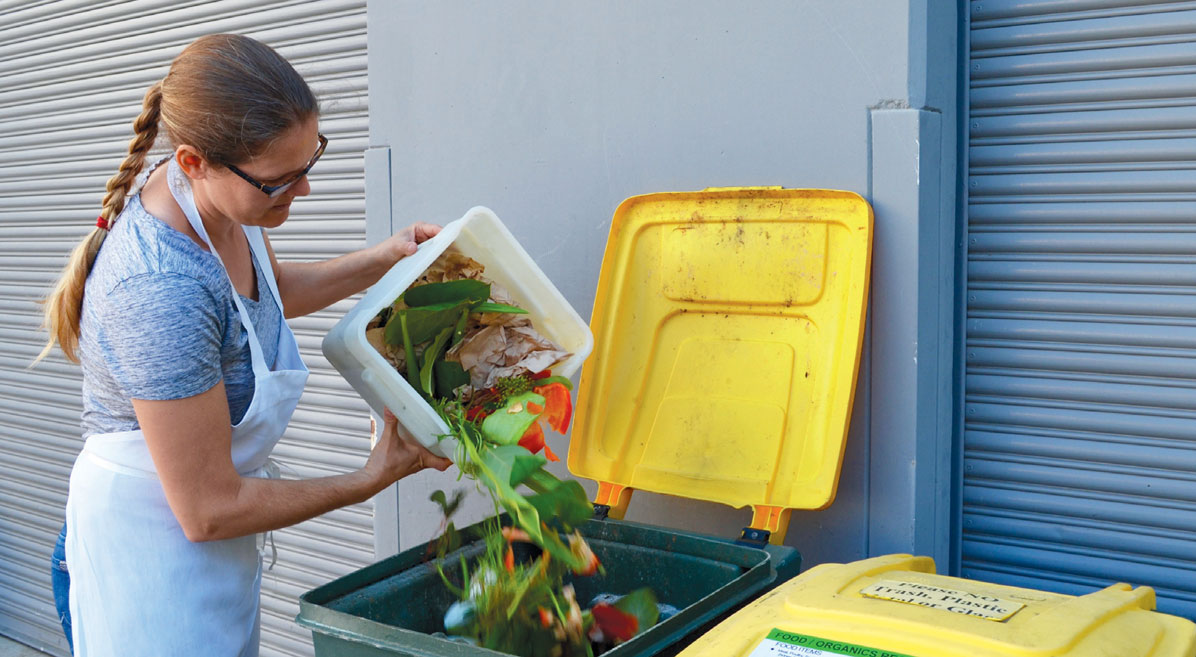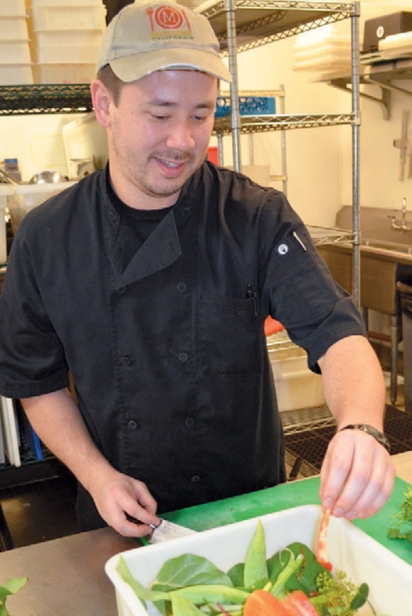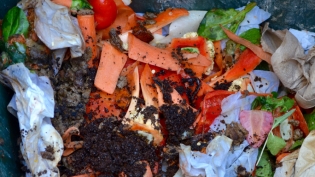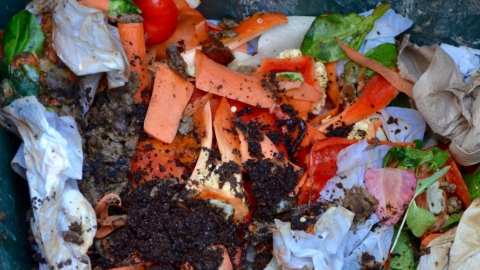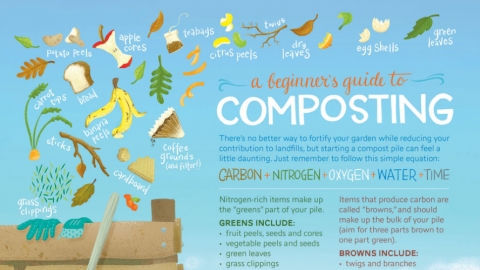Trash Talk
Don’t throw away vegetable peelings. And not overripe produce, either. Instead, we’re encouraged to put them, and other organic matter, into compost bins to help reduce greenhouse gas emissions and what is added to landfills. Plus, compost is good for the soil in our gardens.
While composting is something many of us choose to do, starting April 1 the State of California won’t give designated large businesses that generate a great deal of organic waste the option. Under Assembly Bill 1826, they’ll be required to compost or otherwise recycle any organic waste they produce. (See Organics Recycling Law Summary for details.)
It’s the first of several dates specified in the bill—co-authored by Assemblymember Das Williams, whose district includes portions of Ventura and Santa Barbara counties—which will phase increasingly smaller businesses into the requirements.
The first phase is likely to affect schools, hospitals, large supermarkets, hotels and convention centers, but restaurants and many other businesses will ultimately be included under the law.
It’s clear why the bill was written when you consider that Californians dispose of approximately 30 million tons of waste in landfills each year, according to the California Department of Resources Recycling and Recovery (aka CalRecycle). Over 30% of it—or in the neighborhood of 10 million tons per year—is organic waste that could be used for compost or mulch. The breakdown of organic wastes in landfills has been identified as a significant source of greenhouse gas emissions, which the state is mandated to reduce with the 2006 passage of the California Global Warming Solutions Act.
WHAT MUST BUSINESSES DO?
Affected businesses that fall under the law’s requirements will need to separate organic waste items (those that derived from living matter) from other waste. Including food-soiled paper in the definition of organic waste should make it easier for restaurants in particular to do this, but the law still presents challenges. The key issues can be summed up in two words: time and space.
TIME
The April 1 deadline may catch some unprepared businesses off guard. Waste haulers Waste Management and E.J. Harrison & Sons already have been running pilot commercial organics recycling programs, but only for a subset of their customers. E.J. Harrison is also conducting audits of all of its commercial customers to determine how much organic waste they are generating.
“We are in the planning stages to call on customers to evaluate their service needs for organics and to give them educational material,” says Nan Drake, government affairs and public relations representative for E.J. Harrison, in a February conversation. The idea is to explain what organic waste is and other ways to reduce it, such as donating surplus to food banks or using food more efficiently in their business.
Steve Lee, Waste Management’s organic waste representative, says the company is working closely with businesses to implement a successful organic recycling program that accommodates service frequencies, placement logistics and container equipment.
Ultimately, however, it’s the businesses generating organic waste that are responsible for compliance.
Both waste companies are relying heavily on Agromin in Oxnard, by far the county’s largest organics recycler, to process the material collected through their pilot commercial organic recycling programs.
The company expects to have sufficient capacity to accept the volume anticipated when the rule goes into effect, says Agromin CEO Bill Camarillo. Agromin also has a plan to meet future compliance deadlines, when even more businesses will become subject to the rules. That plan, however, is contingent in part upon receiving the required permits for a new environmental organic park.
Extending food waste collection service to households likely won’t be given consideration until the capacity to manage all commercial organics is taken care of, says Donald Sealund, E.J. Harrison’s food waste coordinator.
SPACE
Haulers may not be able to collect separated organics from businesses daily, or in some cases even more than two or three times a week. Typical trash dumpsters often aren’t leak proof, so unless the majority of moisture can be removed from the waste, it means storing the material in smaller carts, similar to those provided to households.
No matter the type of container used, businesses will need to have the space to store them, taking into consideration things like proximity to kitchens/generation areas, access for waste trucks, and odor and vermin control.
BUSINESSES SEEKING AND FINDING SOLUTIONS
Some proactive Ventura County businesses already have been composting and offer some practical insight into the challenges and potential solutions.
COMMERCIAL ORGANICS COLLECTION
Main Course California, a full-service catering company in Ventura, has participated in E.J. Harrison’s pilot organics collection project for over two years, and Alexander’s Restaurant at Four Points by Sheraton Ventura Harbor Resort has for over three.
Both say it’s been a positive experience overall. “I think the hardest thing was staff getting used to the idea that food isn’t trash and that it doesn’t go in the dumpster,” says Liz Patterson-Skoda, the Sheraton’s assistant food and beverage manager. “But it didn’t take long, and it makes trash day so much easier.”
Rachel Main-Holst, executive chef and vice president of Main Course California, agrees. “Food makes the trash so heavy … [the program] saves people’s backs” because they aren’t lifting trash bags and bins full of wet, heavy food waste.
The moisture of the waste does raise one issue both women noted: the importance of keeping the collection containers clean. “You definitely have to wash out your trash can,” says Patterson-Skoda. It hasn’t been a major issue though, nor have things like odor or vermin. Main-Holst noted that the containers E.J. Harrison provided are fully closeable: “We even put fish scraps in there … it hasn’t been a problem .”
Blue Stove, located inside Nordstrom at The Oaks in Thousand Oaks, has participated in the Waste Management pilot program for nearly three years. Chef Peter O’Keefe says both food prep waste and a majority of plate scraps go into the compost bins from Waste Management. Unlike Main Course California and Alexander’s, Blue Stove only puts vegetable matter and eggshells into the compost bins, no meat or other proteins. Still, they find that, overall, the program is not very limiting, and it’s relatively easy to separate the organics.
“It’s clear we’re reducing the amount of waste we send to the landfill significantly,” adds O’Keefe.
Finding a viable solution isn’t always easy or, in some cases, even possible. To illustrate the point, Rod Cordova, an assistant analyst with the City of Thousand Oaks’ Environmental Programs, tells me about a Westlake Village juice bar that was interested in the pilot food waste collection program. After meeting with City staff and a Waste Management representative, it was determined that the juice bar didn’t have the space to store waste carts, and the waste holding area at the strip mall wasn’t set up for multiple waste carts.
“It’s unfortunate,” says Cordova, “because this type of business generates the kind of waste that is ideal for composting.” That is, clean, 100% fruit and vegetable scraps.
Cordova notes that limited enclosure space will be an ongoing challenge for commercial locations everywhere, particularly in older business areas with existing enclosures that were not designed and built to accommodate multiple dumpsters for recycling and organics. “Many planning departments require waste bins to be stored in enclosures.” But, he notes, “property owners don’t always have the space or money to invest in making these upgrades.”
DO IT YOURSELF
Looking for solutions to its food waste challenges, California Lutheran University in Thousand Oaks installed both a food pulping system and a food waste dehydrator system when the Ullman Commons was constructed in 2014. Food prep waste from the main kitchen, food scraps and paper products from diners—even compostable plastic cups—go into the pulper.
It processes the waste with water to make it into pulp; an extractor removes most of the water, returning it to the pulping tank for reuse.
Some of the resulting material is placed in the dehydrator system; after about a day, it can then be spread on fields at the campus.
In addition, the CLU SEEd (Sustainable Edible Education) Project recently received a grant from the City of Thousand Oaks to create a new vermicomposting (composting using worms) program on campus. Food preparation waste will be diverted to an industrial- size vermicomposting unit. The resulting castings will be used in the SEEd garden and elsewhere on campus.
“The several approaches we have in place significantly mitigate food waste, much of which previously would have gone into landfills, and we can continue to make progress,” says Samuel Thomas, PhD, CLU associate professor of religion and SEEd program faculty advisor.
Azu restaurant in Ojai is also taking the do-it-yourself approach. The restaurant has been composting plant-based food preparation waste at a nearby orchard for nearly three years and applied the resulting compost to seasonal vegetable beds and fruit trees.
Fish scraps are used to create hugelkultur beds, loosely translated from German to “mound culture”—a gardening technique where woody debris is used as a resource. Dead or downed trees from the orchard, the fish scraps and other organic material are buried, and the natural breakdown and decomposition of the material ultimately mimics the nutrient cycling process that takes place in a natural woodland.
“You’re taking energy that would otherwise go to a dump and using it,” says Azu General Manager Elizabeth Haffner. The restaurant also sends plate scraps to a local heritage pig farm in Ojai, and cooking oil is collected by local partners for converting into biodiesel.
NO SILVER BULLET
The ultimate objectives of AB 1826—keeping organic waste out of landfills and reducing greenhouse gas emissions—are noble, to be sure. Businesses are seeking, finding and even creatively developing their own solutions. But as just about everyone I spoke with pointed out, there is no single answer—no silver bullet.
Businesses, service providers and public officials will have to keep working together. Reducing food waste in the first place will continue to be an important part of the solution and new ideas should always be explored.
And as residents, we should still keep composting.


